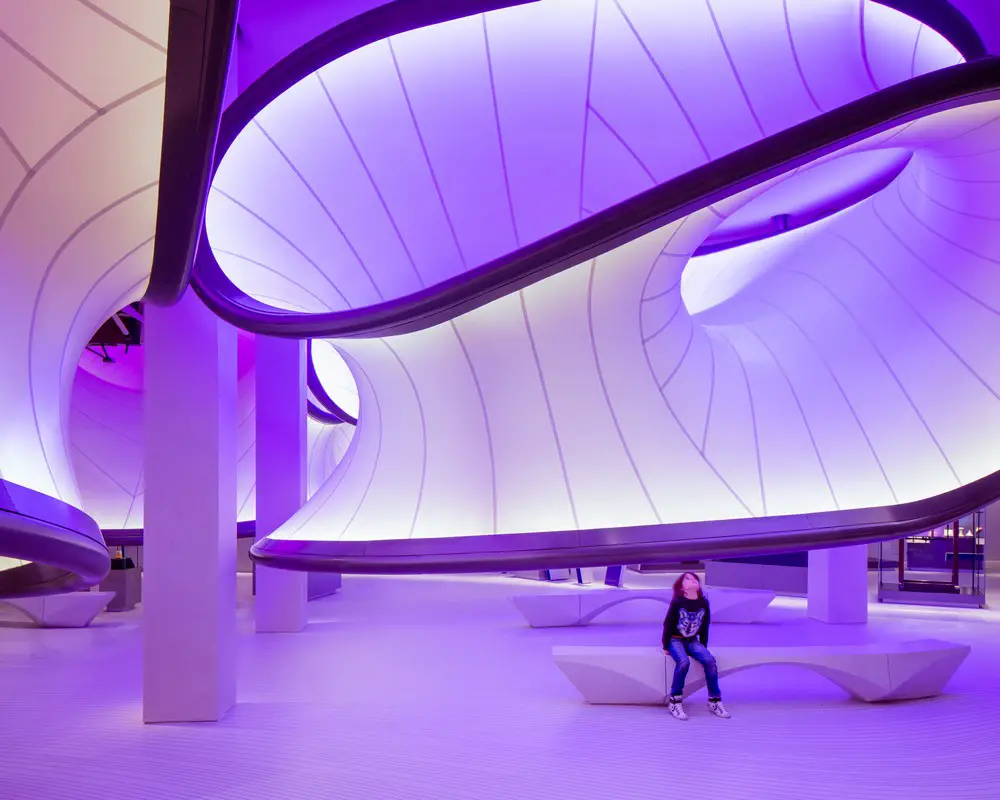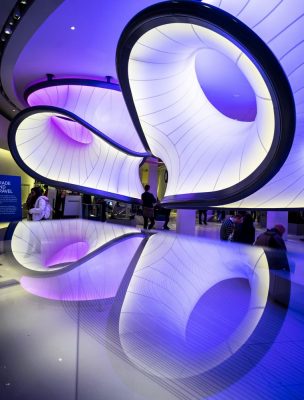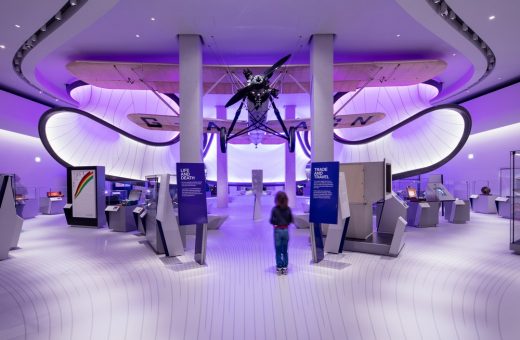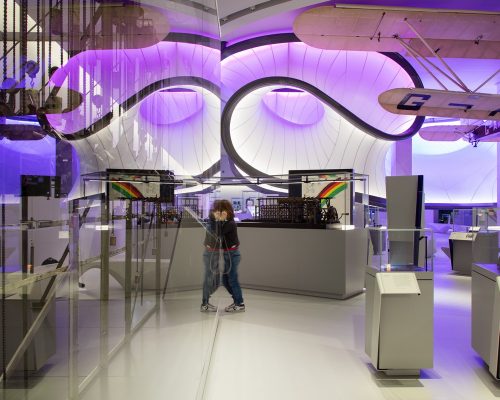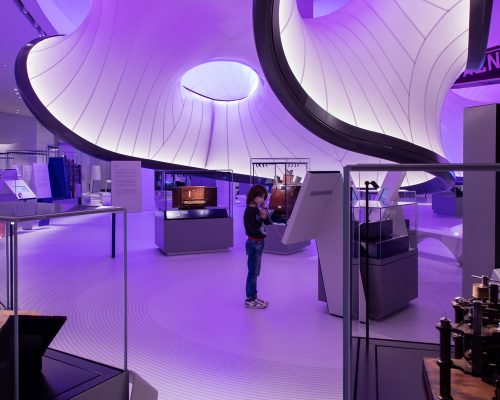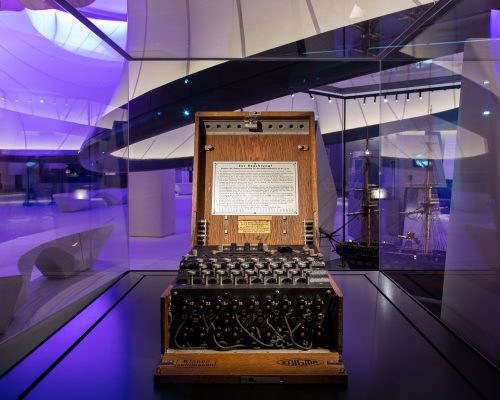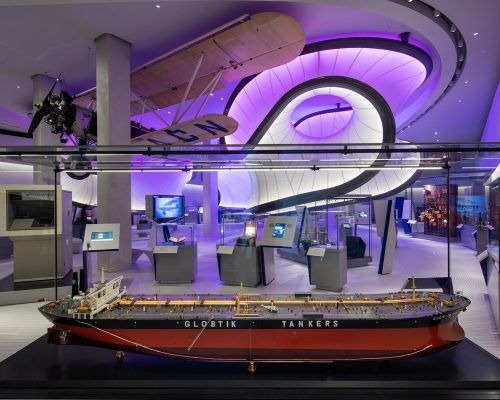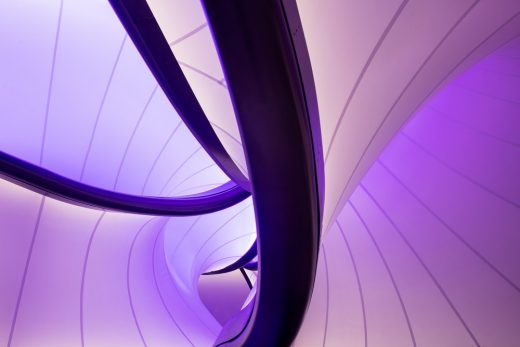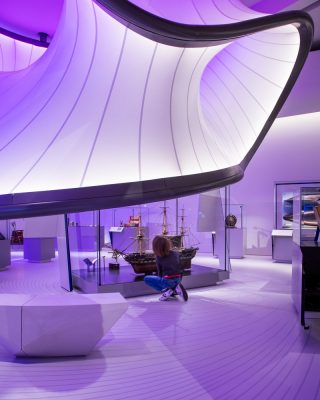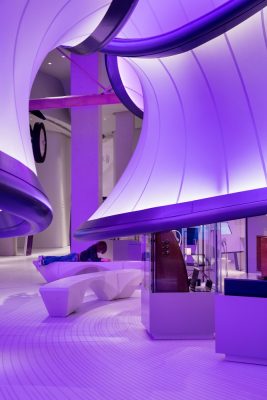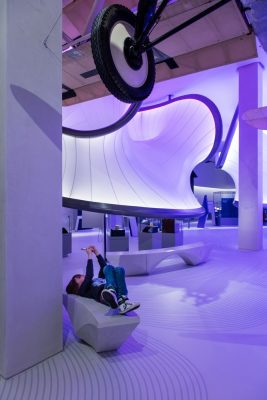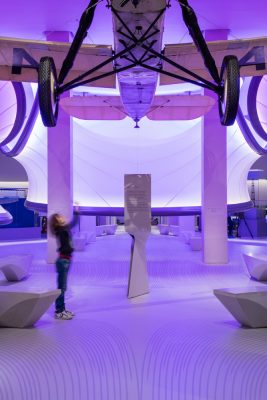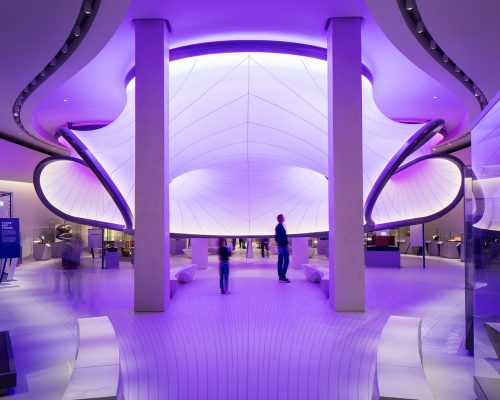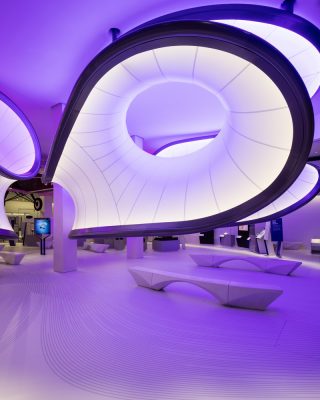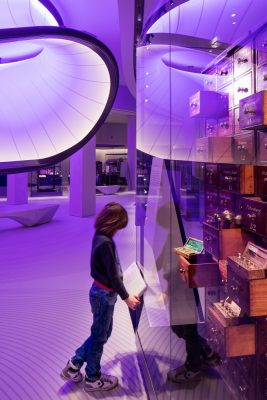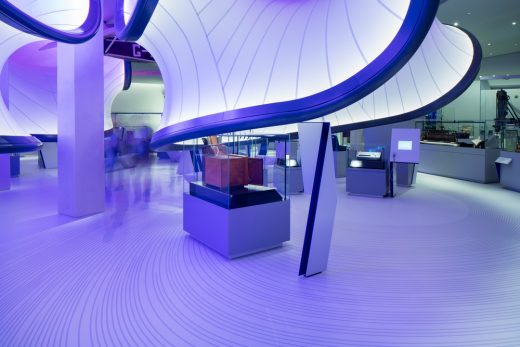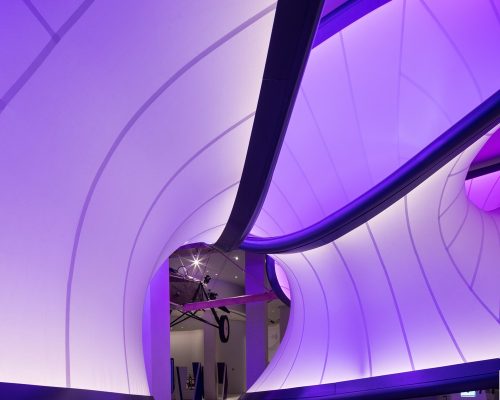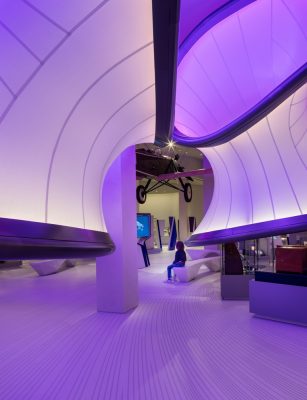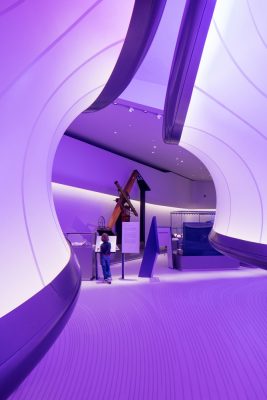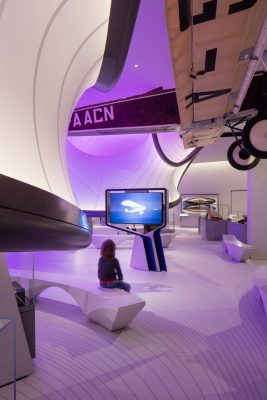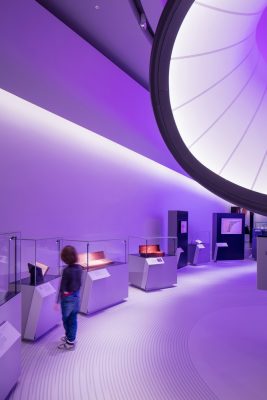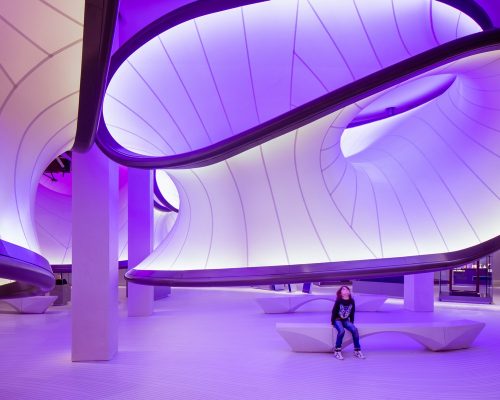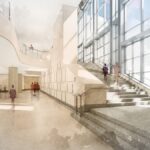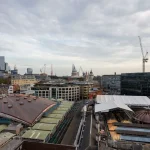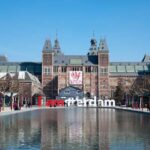Mathematics: The Winton Gallery, Science Museum London Building, Visitors, Architect, Images
Winton Gallery at the Science Museum in London
Architecture Interior at Exhibition Road, South Kensington, England – design by Zaha Hadid Architects
9 Sep 2017
Mathematics: The Winton Gallery News
Design: Zaha Hadid Architects
Location: Science Museum, Exhibition Rd, Kensington, London SW7 2DD, England, UK
Mathematics: The Winton Gallery welcomes a million visitors
A million visitors have explored Mathematics: The Winton Gallery at London’s Science Museum since its opening last December.
The gallery brings together remarkable stories and historical artefacts, highlighting the central role of mathematical practice in all our lives
Positioned at the centre of the gallery is the Handley Page ‘Gugnunc’ aeroplane, built in 1929 for a competition to construct safe aircraft. Ground-breaking aerodynamic research influenced the wing design of this experimental aeroplane, helping to shift public opinion about the safety of flying and to secure the future of the aviation industry.
Photos below: Luke Hayes
This aeroplane encapsulates the gallery’s overarching theme, illustrating how mathematical practice has helped solve real-world problems and in this instance paved the way for the safe passenger flights that we rely on today.
Mathematics defines the gallery’s design. Inspired by the Handley Page aircraft, the design is driven by equations of airflow used in the aviation industry. The layout and lines of the gallery represent the air that would have flowed around this historic aircraft in flight, from the positioning of the showcases and benches to the three-dimensional curved surfaces of the central pod structure.
“This pioneering project has vastly increased visitor numbers to the Mathematics Gallery and is an exemplar project in how architecture can be central to successful curatorial development… the client should be commended for engaging Zaha Hadid Architects as its designers,” explained the RIBA awards jury in May 2017.
The RIBA jury citation continues, “The project is finished to an exacting standard, whilst robust enough to handle the 3.5 million visitors the Science Museum attracts each year. Walls are subtly modelled in gypsum; the floating pod structure is precisely engineered and the precast concrete benches and new floor surfaces are seamless and refined.”
Curator Dr David Rooney said, “Mathematical practice underpins so many aspects of our lives and work. Bringing together these remarkable stories, people and exhibits in this new gallery is inspiring visitors to think about the role of mathematics in a new light.”
The Sunday Times concurred, describing the new gallery as “an environment that fills you with wonder… I found myself uplifted by something pure, floaty and mysterious: the beauty of maths.”
Recipient of an RIBA London Award and nominated by the New London Awards as the city’s best new civic project, Mathematics: The Winton Gallery was recently named a finalist of the Architects’ Journal (AJ) Architecture Awards which showcase the very best built projects in the UK.
Mathematics: The Winton Gallery, London information / images received 070917
7 Dec 2016
Mathematics: The Winton Gallery
Design: Zaha Hadid Architects
Location: London, England
Mathematics: The Winton Gallery opens Science Museum, London
On 8 December 2016 the Science Museum will open an inspirational new mathematics gallery, designed by Zaha Hadid Architects.
Mathematics: The Winton Gallery brings together remarkable stories, historical artefacts and design to highlight the central role of mathematical practice in all our lives, and explores how mathematicians, their tools and ideas have helped build the modern world over the past four centuries.
More than 100 treasures from the Science Museum’s world-class science, technology, engineering and mathematics collections have been selected to tell powerful stories about how mathematics has shaped, and been shaped by, some of our most fundamental human concerns – from trade and travel to war, peace, life, death, form and beauty.
Curator Dr David Rooney said, “At its heart this gallery reveals a rich cultural story of human endeavour that has helped transform the world over the last four hundred years. Mathematical practice underpins so many aspects of our lives and work, and we hope that bringing together these remarkable stories, people and exhibits will inspire visitors to think about the role of mathematics in a new light.”
Positioned at the centre of the gallery is the Handley Page ‘Gugnunc’ aeroplane, built in 1929 for a competition to construct safe aircraft. Ground-breaking aerodynamic research influenced the wing design of this experimental aeroplane, helping to shift public opinion about the safety of flying and to secure the future of the aviation industry. This aeroplane encapsulates the gallery’s overarching theme, illustrating how mathematical practice has helped solve real-world problems and in this instance paved the way for the safe passenger flights that we rely on today.
Mathematics also defines Zaha Hadid Architects’ enlightening design for the gallery. Inspired by the Handley Page aircraft, the design is driven by equations of airflow used in the aviation industry. The layout and lines of the gallery represent the air that would have flowed around this historic aircraft in flight, from the positioning of the showcases and benches to the three-dimensional curved surfaces of the central pod structure.
Mathematics: The Winton Gallery is the first permanent public museum exhibition designed by Zaha Hadid Architects anywhere in the world. The gallery is also the first of Zaha Hadid Architects’ projects to open in the UK since Dame Zaha Hadid’s sudden death in March 2016. The late Dame Zaha first became interested in geometry while studying mathematics at university. Mathematics and geometry have a strong connection with architecture and she continued to examine these relationships throughout each of her projects; with mathematics always central to her work. As Dame Zaha said, “When I was growing up in Iraq, math was an everyday part of life. We would play with math problems just as we would play with pens and paper to draw – math was like sketching.”
Ian Blatchford, Director of the Science Museum Group, said, “We were hugely impressed by the ideas and vision of the late Dame Zaha Hadid and Patrik Schumacher when they first presented their design for the new mathematics gallery over two years ago. It was a terrible shock for us all when Dame Zaha died suddenly in March this year, but I am sure that this gallery will be a lasting tribute to this world-changing architect and provide inspiration for our millions of visitors for many years to come.”
From a beautiful 17th century Islamic astrolabe that uses ancient mathematical techniques to map the night sky, to an early example of the famous Enigma machine, designed to resist even the most advanced mathematical techniques for code breaking during the Second World War, each historic object within the gallery has an important story to tell. Archive photography and film helps to capture these stories, and introduces the wide range of people who made, used or were impacted by each mathematical device or idea.
Some instruments and objects within the gallery clearly reference their mathematical origin. Others may surprise visitors and appear rooted in other disciplines, from classical architecture to furniture design. Visitors will see a box of glass eyes used by Francis Galton in his 1884 Anthropometric Laboratory to help measure the physical characteristics of the British public and develop statistics to support a wider social and political movement he termed ‘eugenics’. On the other side of the gallery is the pioneering Wisard pattern-recognition machine built in 1981 to attempt to re-create the ‘neural networks’ of the brain. This early Artificial Intelligence machine worked, until 1995, on a variety of projects, from banknote recognition to voice analysis, and from foetal growth monitoring in hospitals to covert surveillance for the Home Office.
A richly illustrated book has been published by Scala to accompany the new gallery. Mathematics: How it Shaped Our World, written by David Rooney, expands on the themes and stories that are celebrated in the gallery itself and includes a series of newly commissioned essays written by world-leading experts in the history and modern practice of mathematics.
David Harding, Principal Funder of the gallery and Founder and CEO of Winton said, “Mathematics, whilst difficult for many, is incredibly useful. To those with an aptitude for it, it is also beautiful. I’m delighted that this gallery will be both useful and beautiful.”
Mathematics: The Winton Gallery is free to visit and open daily from 8 December 2016. The gallery has been made possible through an unprecedented donation from long-standing supporters of science, David and Claudia Harding. It has also received generous support from Samsung as Principal Sponsor, MathWorks as Major Sponsor, with additional support from Adrian and Jacqui Beecroft, Iain and Jane Bratchie, the Keniston-Cooper Charitable Trust, Dr Martin Schoernig, Steve Mobbs and Pauline Thomas.
Photography © Luke Hayes
Winton Gallery at the Science Museum in London information / images received 071216
Address: Exhibition Rd, London SW7 2DD
Phone: 0870 870 4868
Zaha Hadid Architects on e-architect
Location: Science Museum, Exhibition Road, West London, SW7 2DD, England, UK
London Building Designs
Contemporary London Architectural Designs
London Architecture Links – chronological list
London Architecture Tours – bespoke UK capital city walks by e-architect
West London Buildings
Natural History Museum London
Design: Alfred Waterhouse, architect
Natural History Museum Gallery
Boodles at 178 New Bond Street, Mayfair, West London
Design: Eva Jiricna Architects
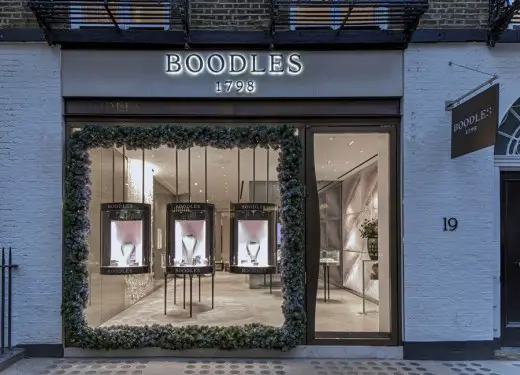
photo from architects office
Boodles on New Bond Street
Imperial College Building, Exhibition Road
Victoria Transport Interchange
London Science Museum Building Context : Ismaili Centre, 1-7 Cromwell Gardens
Comments / photos for the Winton Gallery at the Science Museum in London page welcome
Website: Zaha Hadid Architects

